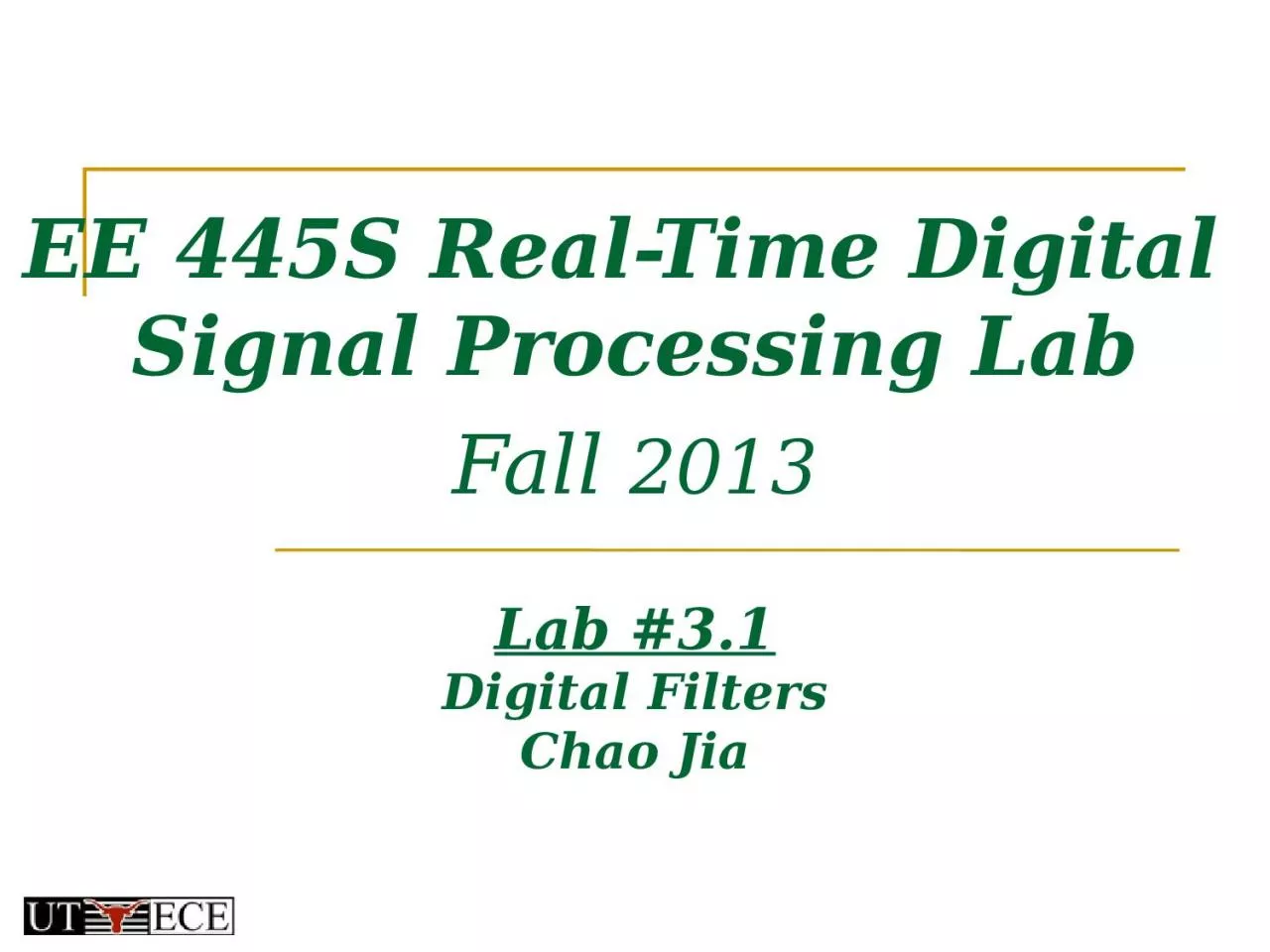

Signal Processing Lab Fall 2013 Lab 31 Digital Filters Chao Jia 2 Outline DiscreteTime Convolution FIR Filter Design Convolution Using Circular Buffer FIR Filter Implementation 3 DiscreteTime Convolution ID: 1031181
Download Presentation The PPT/PDF document "EE 445S Real-Time Digital" is the property of its rightful owner. Permission is granted to download and print the materials on this web site for personal, non-commercial use only, and to display it on your personal computer provided you do not modify the materials and that you retain all copyright notices contained in the materials. By downloading content from our website, you accept the terms of this agreement.
1. EE 445S Real-Time Digital Signal Processing Lab Fall 2013Lab #3.1Digital FiltersChao Jia
2. 2OutlineDiscrete-Time ConvolutionFIR Filter DesignConvolution Using Circular BufferFIR Filter Implementation
3. 3Discrete-Time ConvolutionRepresented by the following equationFilter implementations will use the second version (hold h[n] in place and flip-and-slide x[n] about h[n])Z-transform of convolutionfor z є ROC(X) ∩ ROC(H)
4. 4DT Convolution Sinusoidal Response
5. 5FIR Filters Design & ImplementationAn FIR filter does discrete-time convolution
6. 6FIR Filters Design & ImplementationDesignUse the Filter Design & Analysis Tool (fdatool) to obtain the filter co-efficientsSpecifications given in the task listWrite convolution function to implement FIR filter given coefficients from fdatool
7. Linear bufferHow to get outputIf we want to calculate the output y[n]Now x[n+1] is entered and we want y[n+1]Store the newest sample at the beginning, shift all the elements in the array to right and discard the oldest one7h[0]h[1]h[2]……h[N-3]h[N-2]h[N-1]x[n]x[n-1]x[n-2]……x[n-N+3]x[n-N+2]x[n-N+1]h[0]h[1]h[2]……h[N-3]h[N-2]h[N-1]x[n+1]x[n]x[n-1]……x[n-N+4]x[n-N+3]x[n-N+2]
8. Circular bufferIf we want to calculate the output y[n]Now x[n+1] is entered and we want y[n+1]Only need an index to point where the newest sample isModify the index modulo L (L is the length of the sample buffer) when new sample is entered.8x[n-N+1]x[n]x[n-1]……x[n-N+4]x[n-N+3]x[n-N+2]oldestnewestNewest +1x[n+1]x[n]x[n-1]……x[n-N+4]x[n-N+3]x[n-N+2]newestNewest +1Newest +2oldest
9. Circular bufferIn this way, samples are written into the array in a circular fashionFor the length of circular buffer L:Always choose it to be larger than N.Make sure that L is a power of 2 (for hardware circular buffering) (C6748 DSP requires the size of the circular buffer to be a power of 2)9
10. 10Convolution Using Circular Buffermain(){ int x_index = 0; float y, xcirc[N]; --- ---/*--------------------------------------------*//* circularly increment newest (No %)*/ ++newest; if(newest == N) newest = 0;/*-------------------------------------------*//* Put new sample in delay line. */ xcirc[newest] = newsample;/*-------------------------------------------*//* Do convolution sum */Go on to the next column y = 0; x_index = newest for (k = 0; k < No_of_coeff; k++) { y += h[k]*xcirc[x_index]; /*-------------------------------------*/ /* circularly decrement x_index */ --x_index; if(x_index == -1) x_index = N-1; /*-------------------------------------*/ }...}
11. 11Task List1. Run winDSK and applications “Graphic Equalizer” and “Notch Filter”2. Design FIR filters with fdatool in Matlab3. Implement convolution with linear buffer4. Implement convolution with circular buffer5. Compare the theoretical and experimental magnitude response